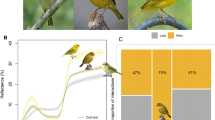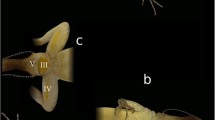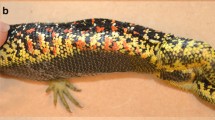Abstract
Recent studies have suggested that structural-based coloration is an honest signal of male genetic and/or conditional quality in sexual selection. However, whether structural coloration functions in intrasexual competition is unknown. We examined whether plumage color functions as a status signal during intrasexual interactions in the red-flanked bushrobin Tarsiger cyanurus; adult males have many blue plumes as structural coloration whereas yearling males and females are olive brown with few blue plumages. Blue males did not always dominate olive-brown males. The number of interactions did not differ with the colors of the two birds involved. The interactions of a blue male and an olive-brown male were less aggressive than those of two blue or of two olive-brown males. In this study, we found that structural plumage coloration may serve as a signal of aggressive intent and lower the escalation level of an aggressive interaction in a manner consistent with hypotheses regarding the evolution of delayed plumage maturation.



Similar content being viewed by others
References
Alan Agresti (1990) Categorical data analysis. Wiley, New York
Andersson M (1994) Sexual selection. Princeton Univ Press, Princeton
Alonso-Alvarez C, Doutelant C, Sorci G (2004) Ultraviolet reflectance affects male–male interactions in the blue tit (Parus caeruleus ultramarinus). Behav Ecol 15:805–809
Clayton D H (1991) Coevolution of avian grooming and ectoparasite avoidance. In: Loye J E, Zuk M (eds) Bird–parasite interactions: ecology, evolution and behaviour. Oxford University Press, Oxford, pp 258–289
Collis K, Borgia G (1992) Age-related effects of testosterone, plumage, and experience on aggression and social-dominance in juvenile male satin bowerbirds (Ptilonorhynchus violaceus). Auk 109:422–434
Collis K, Borgia G (1993) The costs of male display and delayed plumage maturation in the satin bowerbird (Ptilonorhynchus violaceus). Ethology 94:59–71
Cramp S (1988) The Red-flanked bluetail. In: Cramp S (ed) The birds of the Western Palearctic. Handbook of birds in Europe, the Middle East and Africa, vol 5. Oxford University Press, Oxford, pp 664–671
Dugatkin LA (1997) Winner and loser effects and the structure of dominance hierarchies. Behav Ecol 8:583–587
Dugatkin LA (2001) Bystander effects and the structure of dominance hierarchies. Behav Ecol 12:348–352
Fox DL (1976) Animal biochromes and structural colors: physical, chemical, distributional and physiological features of colored bodies in the animal world. University of California Press, Barkley
Fox HM, Vevers G (1960) The nature of animal colors. Macmillan, New York
Grafen A (1990) Biological signals as handicaps. J Theor Biol 144:517–546
Greene E, Lyon BE, Muehter VR, Ratcliffe L, Oliver SJ, Boag PT (2000) Disruptive sexual selection for plumage coloration in a passerine bird. Nature 407:1000–1003
Hamilton WD, Zuk M (1982) Heritable true fitness and bright birds: a role for parasites? Science 218:384–387
Hansen AJ, Rohwer S (1986) Coverable badges and resource defense in birds. Anim Behav 34:69–76
Hill GE (1999) Mate choice, male quality, and carotenoid-based plumage coloration. In: Adams NJ, Slotow RH (eds) Proceedings of the 22nd international ornithology congress. Durban, South Africa, pp 1654–1668
Hill GE, Montgomerie R (1994) Plumage color signals nutritional condition in the t house finch. Proc R Soc Lond B 258:47–52
Hoelzer GA (1989) The good parent process of sexual selection. Anim Behav 38:1067–1078
Keyser AJ, Hill GE (2000) Structurally based plumage coloration is an honest signal of quality in male blue grosbeaks. Behav Ecol 11:202–209
Kodric-Brown A, Brown JH (1984) Truth in advertising: the kinds of traits favored by sexual selection. Am Nat 124:309–323
Ligon DJ (1999) The evolution of avian breeding systems. Oxford University Press, Oxford
Lyon BE, Montgomerie R (1986) Delayed plumage maturation in passerine birds: reliable signaling by subordinate males? Evolution 40:605–615
Mateos C, Carranza J (1997) The role of bright plumage in male-male interactions in the ring-necked pheasant. Anim Behav 54:1205–1214
McGraw KJ, Dale J, Mackillop EA (2003) Social environment during moult and the expression of melanin-based plumage pigmentation in male house sparrows (Passer domesticus). Behav Ecol Sociobiol 53:116–122
McGraw KJ, Hill GE (2000) Carotenoid-based ornamentation and status signaling in the house finch. Behav Ecol 11:520–527
McGraw KJ, Mackillop EA, Dale J, Hauber M (2002) Different colors reveal different information: how nutritional stress affects the expression of melanin- and structurally based ornamental plumage. J Exp Biol 205:3747–3755
Muehter VR, Greene E, Ratcliffe L (1997) Delayed plumage maturation in Lazuli buntings: tests of the female mimicry and status signaling hypotheses. Behav Ecol Sociobiol 41:281–290
Møller AP (1987a) Social control of deception among status signaling house sparrows (Passer domesticus). Behav Ecol Sociobiol 20:307–311
Møller AP (1987b) Variation in badge size in male house sparrows (Passer domesticus): evidence for status signaling. Anim Behav 35:1637–1644
Nakamura T (1995) The red-flanked bluetail. In: Nakamura T, Nakamura M (eds) Bird guide to behaviour of Japanese wildbirds. Non-waterbirds edition, Hoikusya, Tokyo (in Japanese) pp 177
Owens IPF, Hartley IR (1998) Sexual dimorphism in birds: Why are there so many different forms of dimorphism? Proc R Soc Biol Sci B 265:397–407
Pryke SR, Andersson S, Lawes MJ, Piper SE (2002) Carotenoid status signaling in captive and wild red-collared widowbirds: independent effects of badge size and color. Behav Ecol 13:622–631
Pryke SR, Lawes MJ, Andersson S (2001) Agonistic carotenoid signaling in male red-collared widowbirds: aggression related to the color signal of both the territory owner and model intruder. Anim Behav 62:695–704
Rohwer S (1975) The social significance of avian winter plumage variability. Evolution 29:593–610
Rohwer S (1977) Status signaling in Harris’ sparrows: some experiments in deception. Behaviour 61:107–128
Rohwer S, Retweu SD, Niles DM (1980) Delayed maturation in passerine plumages and the deceptive acquisition of resources. Am Nat 131:556–572
Senar JC (1999) Plumage coloration as a signal of social status. In: Adams NJ, Slotow RH (eds) Proceedings of the 22nd international ornithology congress. Durban, South Africa, pp 1669–1686
Siefferman L, Hill GE (2003) Structural and melanin coloration indicate parental effort and reproductive success in male eastern bluebirds (Sialia sialis). Behav Ecol 14:855–861
Siefferman L, Hill GE (2005) UV-blue structural coloration and competition for nest boxes in male eastern bluebirds (Sialia sialis). Anim Behav 69:67–72
Studd MV, Robertson RJ (1985) Evidence for reliable badges of status in territorial yellow warblers (Dendroica petechia). Anim Behav 33:1102–1112
The Ornithological Society of Japan (ed) (2000) Check-list of Japanese birds, 6th revised edn. The Ornithological Society of Japan, Obihiro
Zahavi A (1975) Mate selection—a selection for a handicap. J Theor Biol 53:204–214
Acknowledgements
We are extremely grateful to Mr. K. Tanaka for his assistance throughout the study. Dr. Eiiti Kasuya provided critical comments on statistical analysis. Critical comments from Dr. Barbara Ballentine and an anonymous reviewer improved the manuscript greatly. Y. Ushida and Y. Sudo helped in the field. We also thank the staff of the Higashi-Fuji-sansou and Kikuya mountain loges who encouraged our fieldwork.
Author information
Authors and Affiliations
Corresponding author
About this article
Cite this article
Morimoto, G., Yamaguchi, N. & Ueda, K. Plumage color as a status signal in male–male interaction in the red-flanked bushrobin, Tarsiger cyanurus. J Ethol 24, 261–266 (2006). https://doi.org/10.1007/s10164-005-0187-x
Received:
Accepted:
Published:
Issue Date:
DOI: https://doi.org/10.1007/s10164-005-0187-x




